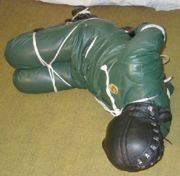Strict bondage

m (→See also: Format) |
(→See also: Two more) |
||
| Line 12: | Line 12: | ||
<TR> | <TR> | ||
<TD width="10%"> | <TD width="10%"> | ||
| + | * [[Ball tie]] | ||
* [[Bondage positions and techniques]] | * [[Bondage positions and techniques]] | ||
* [[Bondage: Safety]] | * [[Bondage: Safety]] | ||
| + | * [[Bondage suit]] | ||
| + | * [[Forniphilia]] | ||
* [[Hogtie]] | * [[Hogtie]] | ||
* [[Hogtie bondage]] | * [[Hogtie bondage]] | ||
| − | |||
| − | |||
</TD> | </TD> | ||
<TD width="20%"> | <TD width="20%"> | ||
| + | * [[Hojojutsu]] | ||
* [[Predicament bondage]] | * [[Predicament bondage]] | ||
* [[Punishment suit]] | * [[Punishment suit]] | ||
Revision as of 13:09, 2 October 2012
Strict bondage is any form of bondage where the bound person is unable to free themselves and mobility is greatly restricted. It will often include a blindfold and/or a gag.
The most popular method of strict bondage is probably the hogtie. A ball tie is also effective.
Escape may be made more difficult by a variety of techniques. These include for example ensuring that all knots are out of reach, rendering the fingers useless with duct tape or bondage mittens and securing straps with padlocks. A blindfold is itself useful in this regard, since it is harder to escape when you cannot see what to do.
Safety
A person in strict bondage is by definition completely helpless. Close monitoring to ensure that they are not in danger is therefore essential.
See also
| This article is a stub. You can help by adding to it. |
